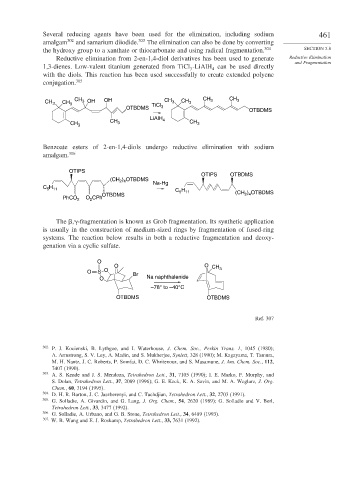Page 488 - Advanced Organic Chemistry Part B - Reactions & Synthesis
P. 488
Several reducing agents have been used for the elimination, including sodium 461
amalgam 302 and samarium diiodide. 303 The elimination can also be done by converting
the hydroxy group to a xanthate or thiocarbonate and using radical fragmentation. 304 SECTION 5.8
Reductive elimination from 2-en-1,4-diol derivatives has been used to generate Reductive Elimination
and Fragmentation
1,3-dienes. Low-valent titanium generated from TiCl -LiAlH can be used directly
3
4
with the diols. This reaction has been used successfully to create extended polyene
conjugation. 305
CH 3 CH 3 CH 3 OH OH TiCl CH 3 CH 3 CH 3 CH 3
OTBDMS 3 OTBDMS
LiAlH
CH 4
CH 3 3 CH 3
Benzoate esters of 2-en-1,4-diols undergo reductive elimination with sodium
amalgam. 306
OTIPS
OTIPS OTBDMS
(CH ) OTBDMS Na-Hg
2 4
C H 11 C H
5
5 11
2 4
OTBDMS (CH ) OTBDMS
PhCO 2 O CPh
2
The , -fragmentation is known as Grob fragmentation. Its synthetic application
is usually in the construction of medium-sized rings by fragmentation of fused-ring
systems. The reaction below results in both a reductive fragmentation and deoxy-
genation via a cyclic sulfate.
O
O O CH 3
O S O
Br
O Na naphthalenide
–78° to –40°C
OTBDMS OTBDMS
Ref. 307
302
P. J. Kocienski, B. Lythgoe, and I. Waterhouse, J. Chem. Soc., Perkin Trans. 1, 1045 (1980);
A. Armstrong, S. V. Ley, A. Madin, and S. Mukherjee, Synlett, 328 (1990); M. Kagayama, T. Tamura,
M. H. Nantz, J. C. Roberts, P. Somfai, D. C. Whritenour, and S. Masamune, J. Am. Chem. Soc., 112,
7407 (1990).
303 A. S. Kende and J. S. Mendoza, Tetrahedron Lett., 31, 7105 (1990); I. E. Marko, F. Murphy, and
S. Dolan, Tetrahedron Lett., 37, 2089 (1996); G. E. Keck, K. A. Savin, and M. A. Weglarz, J. Org.
Chem., 60, 3194 (1995).
304
D. H. R. Barton, J. C. Jaszberenyi, and C. Tachdjian, Tetrahedron Lett., 32, 2703 (1991).
305 G. Solladie, A. Givardin, and G. Lang, J. Org. Chem., 54, 2620 (1989); G. Solladie and V. Berl,
Tetrahedron Lett., 33, 3477 (1992).
306 G. Solladie, A. Urbano, and G. B. Stone, Tetrahedron Lett., 34, 6489 (1993).
307
W. B. Wang and E. J. Roskamp, Tetrahedron Lett., 33, 7631 (1992).

